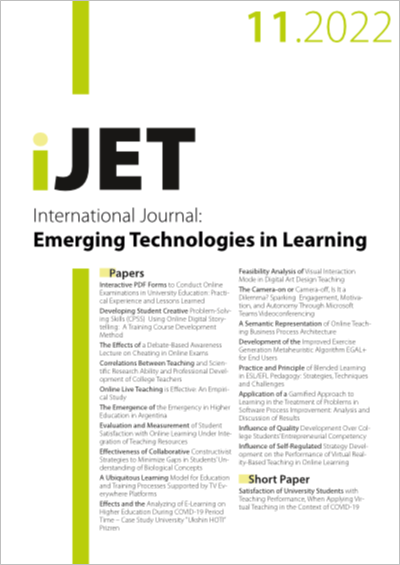Influence of Self-Regulated Strategy Development on the Performance of Virtual Reality-Based Teaching in Online Learning
DOI:
https://doi.org/10.3991/ijet.v17i11.31759Keywords:
online learning, self-regulated strategy development model (SRSD), virtual reality, experimental researchAbstract
Virtual reality technology has been fully integrated into the field of education. Such technology has become the focus of online learning that uses efficient and advanced virtual reality technology to improve the efficiency of learners. Online learning also gives full play to the characteristics of free learning time, flexible location, and free learning pace. Although online learning also easily leads to low efficiency due to physical isolation, it can effectively improve the performance of virtual reality-based teaching by using the self-regulated strategy development (SRSD) model. Based on this model, an experiment was conducted on online teaching course for first-year linguistics students of a provincial graduate school in China to test the influence of the model on the performance of virtual reality-based teaching in online learning. Results show that after the SRSD model, a significant difference is observed between pretest scores and post-test scores of graduate students in the experimental group (t=−4.925, p=0.000). A significant difference is observed between pretest self-regulation and post-test self-regulation of graduate students in the experimental group (t=−7.505, p=0.000). Finally, significant differences are observed between the experimental and control groups in the improvement of post-test scores and post-test self-regulation. Conclusions are of important reference value for enriching the application of the SRSD model in virtual reality-based teaching, improving the self-regulation ability of students, and improving the performance of learners by adopting a model more suitable for the characteristics of online teaching.
Downloads
Published
How to Cite
Issue
Section
License
Copyright (c) 2022 Huadong Shen, Li Li

This work is licensed under a Creative Commons Attribution 4.0 International License.



